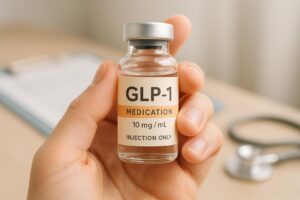When Were GLP-1 Agonists Approved for Weight Loss?

Imagine a world where a medication not only helps control blood sugar but also promotes significant weight loss, drastically improving a person’s quality of life. This is not a distant dream but a reality brought to life by glucagon-like peptide-1 (GLP-1) agonists. These innovative medications have transformed the landscape of obesity treatment, providing a scientifically-backed option for those struggling with weight management.
In this blog post, we will delve into the timeline of GLP-1 agonists, particularly focusing on when they were approved for weight loss. We will explore their journey from diabetes treatment to a powerful tool in obesity management, the mechanisms through which they work, and the implications for those seeking personalized weight loss solutions. By the end, you will have a comprehensive understanding of GLP-1 agonists and their significance in the realm of weight management, enhancing your knowledge of the evolving landscape of obesity treatment.
Introduction
The increasing prevalence of obesity has made it a major public health concern, affecting millions of individuals worldwide. According to the World Health Organization (WHO), obesity has nearly tripled since 1975, with over 1.9 billion adults classified as overweight. This alarming statistic highlights the urgent need for effective weight management solutions. Enter GLP-1 agonists.
Initially developed as a treatment for type 2 diabetes, GLP-1 agonists have gained recognition for their weight loss benefits. The purpose of this blog post is to trace the approval journey of GLP-1 agonists for weight loss, emphasizing the significance of these medications in contemporary healthcare. We will cover their historical context, FDA approvals, mechanisms of action, and the implications for patients.
Through our exploration, we aim to empower readers with knowledge about GLP-1 agonists and how they can play a pivotal role in personalized weight loss strategies.
The Historical Context of GLP-1 Agonists
Discovery and Early Development
The groundwork for GLP-1 agonists began in the 1970s when researchers first identified the role of incretin hormones in glucose metabolism. GLP-1, a hormone produced in the intestines, plays a crucial role in regulating blood sugar levels by stimulating insulin secretion from the pancreas and inhibiting glucagon release.
In 2005, the first GLP-1 agonist, exenatide, was approved by the U.S. Food and Drug Administration (FDA) for the treatment of type 2 diabetes. This marked a significant milestone in diabetes management, as it provided a new therapeutic option that enhanced glycemic control without causing weight gain—a common side effect of many traditional diabetes medications.
The Shift Toward Weight Management
As researchers began to observe the additional benefits of GLP-1 agonists, particularly their potential for weight loss, interest in their application for obesity treatment grew. In 2014, liraglutide became the first GLP-1 agonist approved for weight management under the brand name Saxenda, marking a pivotal moment in the treatment of obesity. This approval was based on clinical trials demonstrating that participants lost an average of 8% of their body weight after 56 weeks of treatment.
In 2021, the landscape changed dramatically when the FDA approved semaglutide, marketed as Wegovy, for chronic weight management. This decision represented a breakthrough in obesity treatment, as semaglutide demonstrated even more significant weight loss results, averaging around 15-20% weight loss in clinical trials.
The Mechanism of Action of GLP-1 Agonists
Understanding how GLP-1 agonists work is essential to appreciating their role in weight management. These medications mimic the action of naturally occurring GLP-1, binding to GLP-1 receptors in the brain and body.
Appetite Regulation
One of the primary mechanisms through which GLP-1 agonists promote weight loss is appetite regulation. By acting on specific areas of the brain, GLP-1 agonists enhance feelings of fullness (satiety) and reduce hunger. This leads to decreased food intake, making it easier for individuals to adhere to a calorie deficit necessary for weight loss.
Slowing Gastric Emptying
GLP-1 agonists also slow gastric emptying, which means that food remains in the stomach longer. This delayed gastric emptying contributes to sustained feelings of fullness, preventing overeating and helping individuals manage their portion sizes effectively.
Enhanced Insulin Secretion
In addition to their appetite-suppressing effects, GLP-1 agonists stimulate insulin secretion in response to meals, which helps lower blood sugar levels. This dual action of reducing appetite while improving glycemic control makes GLP-1 agonists a valuable tool for individuals with obesity and type 2 diabetes.
The Journey of Approval: Key Milestones
2005: First Approval for Diabetes
As previously mentioned, exenatide was the first GLP-1 agonist approved by the FDA for the treatment of type 2 diabetes. This approval laid the foundation for future developments in this class of medications.
2014: Liraglutide for Weight Loss
The approval of liraglutide as Saxenda marked the first time a GLP-1 agonist was authorized specifically for weight management. This was a significant achievement, as it acknowledged the role of GLP-1 agonists in addressing obesity as a chronic disease.
2021: Semaglutide’s Breakthrough Approval
The approval of semaglutide for chronic weight management was a watershed moment in obesity treatment. Clinical trials showed that semaglutide not only helped individuals lose weight but also significantly improved various obesity-related health conditions, such as hypertension and dyslipidemia.
Implications for Personalized Weight Loss Solutions
At TrimRx, we believe that effective weight management requires a personalized approach. Our journey began with a shared vision to help individuals embrace healthier lifestyles through clinically proven, personalized weight loss solutions. By merging advanced medical science with compassionate care, we offer our clients a user-friendly platform that provides medically supervised care tailored to their unique needs.
The Role of Personalized Assessment
To ensure that individuals receive the most effective treatment, we encourage readers to take our free assessment quiz. This quiz helps determine eligibility for our prescription weight loss medications, including compounded semaglutide and oral semaglutide. By personalizing treatment plans, we can enhance the chances of successful weight management.
Take our free assessment quiz to see if you qualify for our prescription weight loss medications: Take the Quiz.
Supporting Wellness with Quick-Access Supplements
In addition to our personalized weight loss programs, we also offer quick-access supplements designed to support overall wellness during the weight loss journey. Our GLP-1 Daily Support and Weight Loss Boost supplements are available for immediate purchase, providing additional resources to help individuals achieve their weight loss goals.
Explore our quick-access supplements:
The Future of GLP-1 Agonists in Weight Management
As the research surrounding GLP-1 agonists continues to evolve, so too does our understanding of their potential applications in obesity treatment. Ongoing studies are exploring combination therapies that may enhance weight loss outcomes, as well as investigating the long-term effects of GLP-1 agonists on weight maintenance.
Addressing Challenges and Concerns
While GLP-1 agonists have shown promise in weight management, it is crucial to address potential side effects and concerns. Common side effects include gastrointestinal symptoms such as nausea and diarrhea. However, these side effects often diminish over time as individuals adjust to the medication.
At TrimRx, we emphasize the importance of transparent communication and compassionate care. Our personalized approach ensures that clients are supported throughout their weight loss journey, helping them navigate any challenges that may arise.
Conclusion
The journey of GLP-1 agonists from diabetes treatment to obesity management is a testament to the power of scientific innovation and compassionate care. With the approval of medications like liraglutide and semaglutide, individuals struggling with obesity now have access to effective, evidence-based treatment options.
As we continue to explore the potential of GLP-1 agonists, we remain committed to providing personalized weight loss solutions that empower individuals to achieve their health goals. At TrimRx, we believe that sustainable weight loss is attainable through science, empathy, and a transparent approach.
If you are considering embarking on your weight loss journey, we invite you to take our free assessment quiz and discover how our personalized weight loss programs can support you. Together, we can create a healthier future.
FAQ
What are GLP-1 agonists?
GLP-1 agonists are a class of medications that mimic the action of the naturally occurring hormone glucagon-like peptide-1. They help regulate blood sugar levels and promote weight loss.
When were GLP-1 agonists approved for weight loss?
The first GLP-1 agonist approved for weight loss was liraglutide in 2014. Semaglutide was later approved for this indication in 2021, offering more significant weight loss results.
How do GLP-1 agonists work for weight loss?
GLP-1 agonists work by enhancing feelings of fullness, slowing gastric emptying, and stimulating insulin secretion, leading to reduced appetite and lower food intake.
Are there any side effects associated with GLP-1 agonists?
Common side effects include gastrointestinal symptoms such as nausea and diarrhea. However, these side effects often improve over time as individuals adjust to the medication.
How can I get started with a personalized weight loss program?
We encourage you to take our free assessment quiz to determine your eligibility for our prescription weight loss medications. This personalized approach ensures that you receive the most effective treatment for your unique needs. Take the Quiz.

Transforming Lives, One Step at a Time
Keep reading
Tracking Progress With GLP-1: What To Measure
Learn which metrics to track on GLP‑1 therapy—weight, waist, blood sugar, lipids, side effects, and non‑scale wins—and how often to monitor them.
Fatigue Solutions for Ozempic and Wegovy Users
Hydration, protein-rich meals, light activity, and better sleep can reduce medication-related fatigue and help maintain energy during weight-loss treatment.
GLP-1 Medication Side Effect Checker
Worried about GLP-1 medication side effects? Use our free checker for Semaglutide, Liraglutide, and more to learn what to expect and stay informed!



